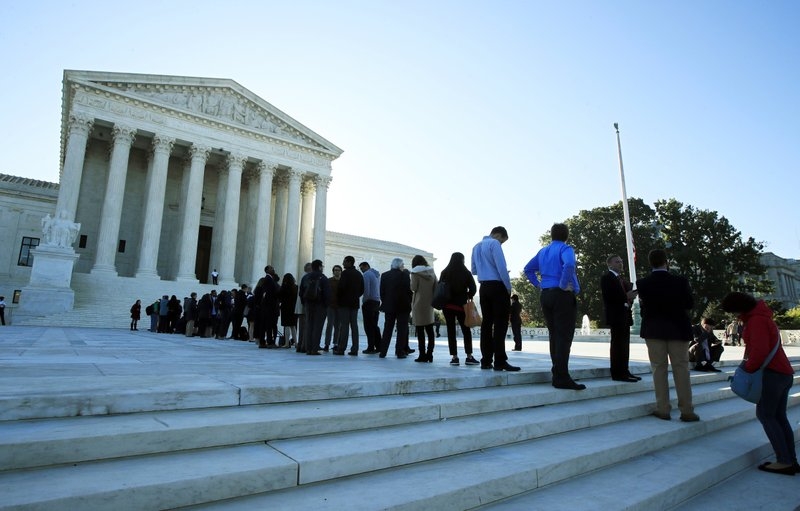National
State by state: redistricting plans facing challenges in court

The U.S. Supreme Court on Monday declined to block the use of legislative districts in Wisconsin and Maryland in separate cases that had alleged unconstitutional partisan gerrymandering. Instead, the high court allowed lower courts to continue considering the claims.
The cases are among several that have been winding their way through the court system, eight years after the 2010 Census provided the basis for the last round of legislative redistricting.
Most of the cases will not affect this year’s elections. But depending on the outcomes, they could set precedents for states to follow for the next round of redistricting after the 2020 Census.
Here’s a look at redistricting cases ruled upon recently or still pending in the courts:
___
WISCONSIN
Partisan breakdown: State Assembly: 64 Republicans, 35 Democrats.
The claim: Partisan gerrymandering.
The case: The U.S. Supreme Court on Monday overturned a November 2016 ruling that had struck down Wisconsin’s state Assembly districts as an unconstitutional partisan gerrymander. The lower court had said the map adopted in 2011 by the Republican-led Legislature and Republican governor violated Democratic voters’ rights to representation by packing Democrats into some districts and spreading them among others, thus diluting their voting power. The U.S. Supreme Court rejected the use of a statewide analysis and said that plaintiffs must prove that their personal voting rights were infringed by the way particular districts were drawn. The ruling sent the case back to a lower federal court for further proceedings.
__
MARYLAND
Partisan breakdown: U.S. House: seven Democrats, one Republican.
The claim: Partisan gerrymandering.
The case: The U.S. Supreme Court on Monday upheld a lower court’s decision declining to grant a preliminary injunction against continued use of the 6th Congressional District boundaries adopted in 2011. A federal lawsuit filed in 2013 by Republican voters alleges that the Democratic governor and Democratic-controlled Legislature unconstitutionally gerrymandered the district to dilute the voting power of Republicans. The district had been held by a 20-year Republican incumbent. It’s since been held by a Democrat. A lower court had put the lawsuit on hold pending guidance from the Supreme Court. The ruling allows it to proceed.
___
TEXAS
Partisan breakdown: U.S. House: 25 Republicans, 11 Democrats. State Senate: 20 Republicans, 11 Democrats. State House: 94 Republicans, 56 Democrats.
The claim: Racial gerrymandering.
The case: U.S. and state House maps enacted in 2011 by the Republican governor and GOP-led Legislature were tossed out in 2012 by a federal court, which produced new interim maps. Those maps were permanently adopted by the Legislature and governor in 2013. But last year, the federal court ruled that some districts were racially gerrymandered to weaken the electoral power of growing minority populations. The U.S. Supreme Court has blocked lower court orders to redraw two congressional districts and nine state House districts for the 2018 elections. It heard arguments April 24 on an appeal of the lower court rulings.
___
NORTH CAROLINA
Partisan breakdown: U.S. House: 10 Republicans, three Democrats. State Senate: 35 Republicans, 15 Democrats. State House: 75 Republicans, 45 Democrats.
The claims: Racial and partisan gerrymandering.
The cases: The U.S. Supreme Court in January temporarily blocked a lower court’s order for state lawmakers to again redraw North Carolina’s congressional districts. The high court is considering whether to schedule arguments on an appeal. Unlike the Wisconsin case, one of the North Carolina cases has plaintiffs from every congressional district. The lower court has ruled that the Republican-led Legislature engaged in unconstitutional partisan gerrymandering when it redrew districts in 2016 in response to a previous court ruling that the 2011 districts were an unconstitutional racial gerrymander. Separately, the U.S. Supreme Court in February temporarily blocked portions of a lower court’s decision redrawing state legislative districts. That case is pending an appeal of a ruling that the legislature’s 2017 redistricting plan violated the state constitution and contained racial biases left over from the maps it originally approved in 2011.
___
PENNSYLVANIA
Partisan breakdown: U.S. House: 10 Republicans, six Democrats, two vacancies.
The claim: Partisan gerrymandering.
The case: The Pennsylvania Supreme Court ruled in January that the U.S. House districts enacted in 2011 by a Republican governor and GOP-led Legislature were an unconstitutional partisan gerrymander favoring Republicans. The Democratic-led court in February imposed new district boundaries that analysts said could boost Democrats’ electoral prospects. The U.S. Supreme Court and a lower federal court both declined to halt or overturn the use of the new districts in this year’s elections.
___
VIRGINIA
Partisan breakdown: U.S. House: seven Republicans, four Democrats. State Senate: 21 Republicans, 19 Democrats. State House: 51 Republicans, 49 Democrats.
The claim: Racial gerrymandering, non-compact districts.
The cases: The state Supreme Court on May 31 rejected a challenge alleging 11 House and Senate districts approved in 2011 were unconstitutional because they were not compact enough. In a separate case, the U.S. Supreme Court last year ordered a lower court to reconsider previously rejected claims that the Legislature and governor unconstitutionally diluted black voting by packing a high percentage of black voters into 11 state House districts. That case is still pending. In yet another case, a federal court in 2016 redrew congressional districts after ruling that black voters had been illegally packed into a particular district to diminish their voting strength elsewhere.
___
GEORGIA
Partisan breakdown: U.S. House: 10 Republicans, four Democrats. State House: 116 Republicans, 64 Democrats.
The claim: Racial gerrymandering.
The case: A federal lawsuit filed June 13 and backed by a national Democratic redistricting group alleges that a U.S. House district was redrawn in 2011 by the state’s Republican-led Legislature and GOP governor to illegally limit the voting influence of black residents. A separate federal lawsuit filed in April 2017 alleges that two state House districts were unconstitutionally gerrymandered by the Republican-led Legislature in 2015 to increase the percentage of white voters and decrease the percentage of black voters. Both Republican incumbents were re-elected over black Democratic challengers in 2016. On June 1, a federal court denied a pre-trial motion to grant a preliminary injunction against continued use of the districts.
___
MICHIGAN
Partisan breakdown: U.S. House: nine Republicans, four Democrats, one vacancy. State Senate: 27 Republicans, 10 Democrats, one vacancy. State House: 63 Republicans, 46 Democrats, one vacancy.
The claim: Partisan gerrymandering.
The case: A federal lawsuit filed in December by Democratic voters alleges the U.S. House and state legislative districts enacted in 2011 by a Republican governor and Republican-led Legislature are unconstitutionally gerrymandered to dilute the voting power of Democrats. Republicans control the Legislature and have a majority of Michigan’s congressional delegation. Critics of the maps so far have survived efforts to have the lawsuit dismissed. A trial is scheduled for next February.
___
OHIO
Partisan breakdown: U.S. House: 11 Republicans, four Democrats, one vacancy.
The claim: Partisan gerrymandering.
The case: A federal lawsuit filed May 23 by the American Civil Liberties Union alleges unconstitutional partisan gerrymandering to the disadvantage of Democratic voters in U.S. House districts that were passed by the Republican-led Legislature and signed by the GOP governor in 2011.
___
ALABAMA
Partisan breakdown: U.S. House: six Republicans, one Democrat. State Senate: 26 Republicans, seven Democrats, one independent, one vacancy. State House: 70 Republicans, 32 Democrats, three vacancies.
The claim: Racial gerrymandering.
The case: A federal lawsuit filed June 13 and backed by a national Democratic redistricting group alleges the U.S. House maps approved in 2011 by the state’s Republican-led Legislature and GOP governor illegally limit the voting influence of black residents. A separate lawsuit previously alleged that state House and Senate maps had packed too many black voters into certain districts. The U.S. Supreme Court in 2015 ordered those maps to be reconsidered by a lower court, which struck down a dozen districts last year. The Legislature then redrew 25 of the 35 state Senate seats and 70 of the 105 state House seats, reducing racial polarization in most districts. The court dismissed a challenge to the new maps last October.
___
LOUISIANA
Partisan breakdown: U.S. House: five Republicans, one Democrat.
The claim: Racial gerrymandering.
The case: A federal lawsuit filed June 13 and backed by a national Democratic redistricting group alleges the U.S. House maps approved in 2011 illegally limit the voting influence of black residents by packing a large number into one majority-minority district and spreading other black voters out among multiple districts. Republicans controlled both legislative chambers and the governor’s office at the time the redistricting plan was approved during a special legislative session.
___
ARKANSAS
Partisan breakdown: U.S. House: four Republicans.
The claim: Racial gerrymandering.
The case: A federal lawsuit filed Feb. 9 by the publisher of the Little Rock Sun, a black community newspaper, alleges that the boundaries of the First Congressional District in eastern Arkansas were drawn to dilute the voting strength of black residents. Democrats controlled both the Legislature and governor’s office during the 2011 redistricting.







